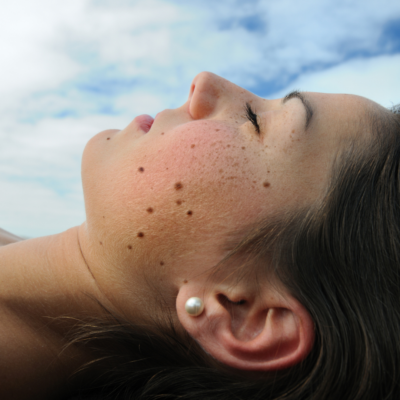
CSI Dermatologists’ Guide to Self-Checking for Skin Cancer
Reviewed by Cathleen Exconde-Mercado, NP
Skin cancer is a serious concern, but the silver lining is that it can often be spotted early if you know what to look for. Many cases of skin cancer are visible and detectable, and it’s often curable if caught in the early stages.
We’re going to tell you how to do your own self-check for possible signs of skin cancer. Regular self-checks are crucial for catching any changes in your skin sooner rather than later. Because if it turns out to be skin cancer, catching it early means less intensive treatment and in some instances, greater chance of survival. We suggest putting a monthly skin check date on your calendar just to be safe.
How to check for melanoma
First up is melanoma, one of the most lethal types of skin cancer. Melanoma nearly always occurs in moles damaged on a cellular level by cumulative UV light. You can monitor your moles by using the ABCDE method.
- A – Asymmetry: When examining moles or spots on your skin, look for any irregular shapes or sizes. Normal moles are usually symmetrical, meaning if you were to draw a line through the middle, both halves would match. If you notice asymmetry, it could be a warning sign.
- B – Border: Pay attention to the borders of your moles and freckles. Healthy freckles and moles typically have smooth, even borders. Irregular, blurred, or jagged edges, could signal cancer.
- C – Color: Most moles are uniform in color, usually a shade of brown. Keep an eye out for moles that have multiple colors or have changed in color over time. Red, white, blue, or black spots within a mole can also be concerning.
- D – Diameter: While melanomas can be small, they are often larger in diameter than most moles. Any mole or spot that is larger than 6 millimeters (about the size of a pencil eraser) should be examined by your CSI dermatologist.
- E – Evolution: Changes in size, shape, color, or sensation of a mole should always be taken seriously. If a mole starts to itch, bleed, or becomes painful, it’s essential to see a dermatologist promptly.
Melanoma can also occur in freckles. If you have freckles, it’s a good idea to use the above method to check those too.
Other skin cancers, other symptoms
Melanoma isn’t the only skin cancer around, unfortunately. There are also the more prevalent squamous cell carcinoma and basal cell carcinoma. Although less likely to be deadly, they can lead to serious irreversible damage, such as the loss of an eye, if not caught in time. Then there’s Merkel cell carcinoma, the skin cancer that caused the tragic death of singer/songwriter Jimmy Buffet. While relatively rare, this cancer can be fast and fatal.
These skin cancers tend to result from years of unprotected sun exposure. That makes them likely to emerge on parts of the body most often hit by UV rays. Your face, ears, neck, shoulders, forearms and the backs of your hands are especially vulnerable. But even the skin between your fingers and toes can be skin cancer sites.
What to look for:
- Blisters: Unexplained blisters, especially ones that ooze or crust over, and don’t go away.
- Sores that don’t heal: If you have a sore that persists for weeks without showing signs of healing, it could be a red flag for skin cancer.
- Red bumps: Any new, red, or pinkish bump that doesn’t go away after a few weeks warrants further investigation.
- Scaliness or crusting: Persistent scaliness, crusting, or rough texture on the skin can indicate a cancerous growth.
Wart-like growths and or scaliness also could be a pre-cancerous condition called actinic keratosis. Your CSI dermatologist can make that determination.
How to perform a self-check
Now that you know what to look for, here’s how to look.
- Find a well-lit room: Natural light is best, but a bright lamp can suffice.
- Undress completely: This ensures you can thoroughly examine all areas of your skin.
- Use a mirror: Use both a hand mirror and a full-length mirror to check hard-to-see areas like your back, scalp, and buttocks.
- Start at your scalp and work your way down: Pay attention to your face, neck, chest, arms, hands, torso, legs, feet, and genital area.
- Use a smartphone or camera: Take photos of any suspicious moles or spots to track changes over time.
- Schedule regular check-ups: Even if you don’t detect anything suspicious, it’s best to see your CSI dermatologist for a professional skin cancer check at least once a year.
Most skin cancers can be successfully treated if caught early. If you notice any changes or have concerns about a mole or spot, don’t hesitate to make an appointment to see a CSI dermatologist. You’ll get peace of mind and if needed, the best in innovative skin cancer care.



 / 291 Reviews
/ 291 Reviews